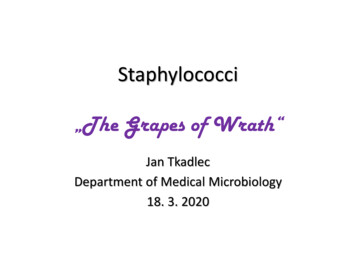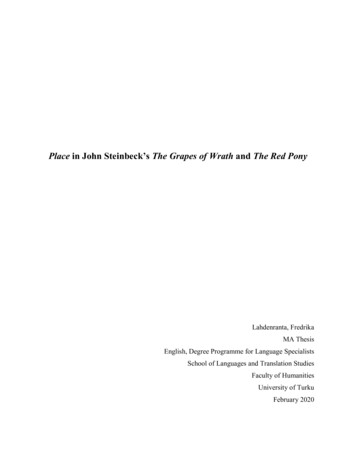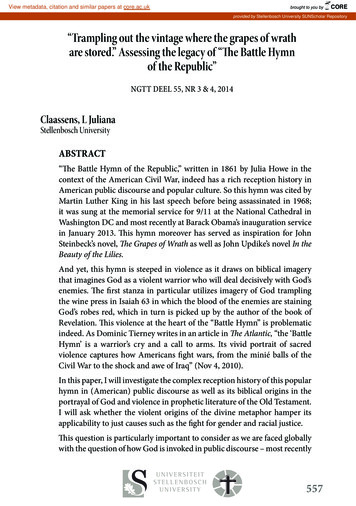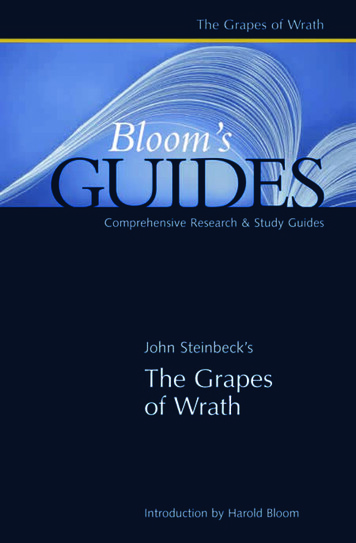
Transcription
Staphylococci„The Grapes of Wrath“Jan TkadlecDepartment of Medical Microbiology18. 3. 2020
Staphylococci more than 50 species Common inhabitants of the skin and mucousmembranes of animals (mainly mammals) Staphylococcus aureus – most important species Coagulase negative Staphylococci (CoNS) – majorityof species but clinically less important S. epidermidis, S. saprophyticus, S. haemolyticus, S. capitis etc. Mostly part of normal microbiome, opportunistic infections,biofilm, foreign body infections
Know your enemy Biological properties of Staphylococci„If you know the enemy and know yourself, you need not fear the result of a hundred battles.“Sun Tzu: Art of War
Microscopic appearance Cell morphology - coccus0,5-1,5 µm in diameterGram-positive (purple)Arranged in grapes-like clusters(staphylé bunch of grapes) May have a capsuleClusters are formed as a resultof cell division mechanismLight microscopy - Gram stainingElectron microscopy
Cultivation of Staphylococci Easy to grow on common media Tolerate high salt concentration (up to 10%)– Selective culture – manitol salt agar– NaCl prevents growth of non-staphylococcal species, while fermentation ofmanitol (color change) differentiate S. aureus (yellow) from CoNSStaph on blood agar
Biochemical properties facultative anaerobes– fermentation is primary source of energy generation grows in presence of oxygen– detoxification of reactive oxygen speciesStaphylococci are catalase positive Differentiation from streptococci (catalase negative)
Production of coagulase – key to staphylococcidifferentiationCoagulase Enzyme that allows conversion of fibrinogen (soluble) to fibrin (insoluble) Two forms– Free – secreted in the surroundings– Bound coagulase – attached to the surface of the bacteria cell Coagulase forms fibrin envelope around site of infection – protectionfrom immune system Important for abscess formationFibrin capsule hides bacterial antigens.Prevents migration of immune cells.Allows to reach high concentration ofbacterial toxins (cytolytic), that destroyimmune cells (PMNs).
Detection of coagulase Tube coagulase test:free coagulase– Rabbit plasma inoculated with staphylococcalcolony, incubation 37 C for 1.5 hoursCoagulation Slide coagulase test (Clumping factor) –detection of bound coagulase Coagulase detection by latexagglutinationVisible clusters
Biochemical differentiation of StaphylococciS. aureusProduction of coagulase differentiate S. aureus( ) from other staphylococci that are clinicallyless important (mostly)CoNS – coagulase negative staphylococciNote: there are rare strains of S. aureus that did not produce coagulaseOther coagulase positive species includes: S. delphini, S. hyicus, S. intermedius, S. lutrae, S.pseudintermedius, and S. schleiferi subsp. Coagulans, however these are rather rare in humanclinical material
Important features of StaphylococciStaphylococci are everywhereOpportunity makes the thiefSources - humans, animals, contaminated surfacesResistance – hard to eradicate the source Antibiotics (ATB) and disinfectants Environment – heat, desiccation, high salt concentration Survive several weeks (months) on contaminated surfaceS. aureus Loaded with toxins and othervirulence factors– Adapted to actively cope with IS Broad spectrum of infections Severe infections (incl. sepsis,endocarditis) Resistance to ATBCoNS Few virulence factors Even more resistant – ATB Form biofilm on foreignbody surfaces Low virulence but hard toeradicate
Staphylococcus aureus Coagulase positive!Major human pathogenGrows in large, round opaque coloniesGolden pigment - aureus golden– Presumed virulence factor (CoNS are non pigmented) Obligate / Opportunistic pathogen– Often infect immunocompromised patients but also healthy adults– Loaded with the toxins and virulence factors Resistance to antibiotics (MRSA) No vaccination Health care associated infections
Recent taxonomy changes Some strains of S. aureus were recentlyreclasified as new species: Staphylococcus argenteus – clinicaly similar toS. aureus, also methicilin resistance Staphylococcus schweitzeri – rarely found inhuman Should be refered to clinicians as S. aureuscomplex, or at least explained that these speciesare not less severe than S. aureus, and are notCoNS
S. aureus carriageCarriage rate varies 10 - 60% of healthyadults1.2.3.Persistent carriers – higher amount ofbacteria for longer timeIntermitent carriers – lower amount ofbacteria for shorter time(Non-carriers)– Varies with geographic location, ethnicity, age,sex and body niches– Risk factors for Staph carriage: Hormonal contraceptives, crowding andhealthcare exposure, low vitamin D status,atopic dermatitis, male gender, diabetes– Protective role of S. aureus carriage againstseverity of future Staph infection modulation of immune response– S. aureus carriage - bacterial competition S. epidermidis, Finegoldia magna,corynebacteria S. pneumoniaeBody niches colonised in S. aureus carriers
Colonisation is risk factor for the S. aureus infection– Surgery, hospitalization, wounds Decolonisation:– Especially for MRSA carriersColonizationstaph is present inor on the bodybut is not causingillness.Infectionstaph is presentand causingillness.
Assault weaponsVirulence factors of S. aureus
S. aureus virulence factors Broad spectrum of virulence factors Mostly carried by the Mobile Genetic Elements Variable, each strain has unique combination ofvirulence factors Categories– Structural components Protein A, clumping factor, teichoic acid, etc.– Enzymes Staphylokinase (Fibrinolysin), Dnase, coagulase, catalase etc.– Toxins Cytotoxins, superantigens, exfoliatins
Virulence factors Function (categories):– Adherence to host tissue – Adhesins– Tissue specific damage, and spread – some toxins– Interference with host immune function – evasins,also toxins
Interference with phagocytosisS. aureus could survive and escape from phagocytic cells
S. aureus as an intracellular pathogen Protection from immune system and antibiotic treatment Survival of S. aureus within:– non-phagocytic cells - endothelial cells, epithelial cells, keratinocytes, fibroblastsand osteoclasts Facilitate persistence and recalcitrance of infection– Macrophages and neutrophiles – „trojan horse“ for spread of staph through thebody Lower rate of S. aureus bacteremia in neutropenic patient – lack of neutrophiles
Evasion of the immunoresponce by S. aureussuperantigens (sAgs) enterotoxins and toxic shocksyndrome toxin-1 that bind the MHC class IIreceptor to T- cell receptors – leading to strongactivation of the T cellsprotein A, binds the Fc region of antibody and theFab regions of the B-cell receptor - blockopsonophagocytosis and cause B-cell deathprotein Map - the MHC class II analogue, whichbinds the T-cell receptor (TCR) and modulatesimune responseS. aureus is highly adapted to cope with humanimmune system
Toxins Intoxication is not necessary infection– Toxins are cause of symptoms not living bacteria1. Cytolytic toxinsa) Hemolysinsb) Leucocidins (PVL)2. Enterotoxins3. Toxic shock syndrome toxin (TSST)4. ExfoliatinsSuperantigens
Cytotoxins: Haemolysin α (Hla): pore-forming,cytotoxic to many types of cells includingmuscle cells, but not neutrophils– Complete haemolysis (looks like beta haemolysisin streptococci)– Main virulence factor – SSTI, sepsis, pneumonia Haemolysin β: degrades sphingomyelinand is toxic for many kinds of cells, includinghuman RBCs.
PVL toxin Panton-Valentin Leukocidin (1932) Bicomponent pore-forming toxin– the LukS-PV and the LukF-PV subunits– Targets: neutrophils, monocytes andmacrophages High host specificity– Induce rapid activation and cell deathin human (and rabbit) neutrophils– But didnt affect murine or simian cells– 2-3% of S. aureus clinical isolates
PVL in pathogenesisAcute, severely necrotising skin infections andnecrotising pneumonia Pneumonia often preceded by influenza High mortality, rapid progressPVL gene mostly in community acquired S. aureusand MRSA (CA-MRSA) infections
PVL action in necrotising pneumoniaInflammation (influenza) cause migration and accumulation of PMNs in lungs.Production of PVL by S. aureus cause rapid lysis of PMNS and release of toxic antimicrobialcompounds.Released serine proteases starts to digest lung tissue causing massive damage
Superantigens (SAgs) Non-specific massive activation of the T-cells Release of cytokines– Can lead to septic shock– Enterotoxins– TSST
Food poisoning Enterotoxins are chemoresistant and heat-stablesecreted polypeptids– More than 20 genes – sea, seb, sec Clinical isolate has on average 6 enterotoxin genes– It can withstand boiling at 100 C for a few minutes– Infected food (milk products, meat, ice cream, ) Incubation period 2-6 hours Interfere with intestine function Clinical symptoms - nausea, vomiting anddiarrhea Self limited, recovery in day or so
Toxic Shock Syndrom TSST 1 (Toxic Shock Syndrome Toxin) Toxin producing S. aureus is usually localized atmucosal sites (nasopharynx, vagina – tampons) orin abscesses released toxin circulate in blood and stimulaterelease of IL-1, IL-2, TNF-α and other cytokines high fever, rash, desquamation, diarrhea,vomiting, hypotension even multiple organ failure Fatal outcome isn t rare
Scalded skin syndrome Exfoliatin - epidermolytic toxin ETA, ETB, ETD– Serine proteases – „molecularscissors“ specifically cut thehuman desmoglein 1 –keratinocyte cell-cell adhesionmolecule– Leading to the disruption ofthe top layers of the skin andfacilitating bacterial skininvasion
Infections caused by Staphylococci
Where you could expect StaphylococciNose or throat (Swabs)CoNS – colonizationS. aureus colonizationor upper airwaysinfectionSkin (swabs, pus, tissue)S. aureus SSTI orcolonisationCoNS - colonisationLungs (sputum)PneumoniaS. aureusUrineUTI: S. aureus(catheter related)S. saprophyticusS. aureus toxicosesEnterotoxicosis – food poisoningToxic shock syndromCSFMeningitidisS. aureus and CoNSHeart (valve tissue)Infective endocarditis:S. aureus or CoNSBlood (bloodculture)BSI: S. aureusCoNS (catheter related)StoolS. aureus rarely cause colitisOsteoarticular infections (pus, tissue)Osteomyelitis, septic arthritis, prostheticjoint infectionS. aureus and CoNS (implant related)
Source of staphylococal infection:– Endogenous – colonization precedes infection(majority of the cases) Decolonization before surgery! Localized and systemic infections From benign to live-threatening
Pathogenesis of S. aureus infectionsColonisationwoundLocalised SSTIInvasion of blood streamBacteremiaAnother localisedSSTISepsisOrgan infection or abscess Endocarditis Pneumonia Other organsOsteomyelitisS. aureus infections are often metastatic- chronicity and recurence
Stages of S. aureus infectionAttachmentLocalised infectionDiseminationDisemination could lead to bloodstream infection and infectionof other organ systems
Why are Staphylococci clinically so important?
Staphylococcus aureus is leading causse of Skinand Soft Tissue Infections (SSTI)MSSA –methicillin sensitive S. aureus; MRSA –methicillin resistant S. aureus;
Skin and soft tissue infections S. aureus is most common cause of SSTI– Cutaneous abscess (folliculitis, carbuncles,furuncles) is hallmark infection of S. aureus SSTIFolliculitisFolliculitis
Furuncle (boil)Carbuncle
ImpetigoWound infectionParonychiaCellulitis
ImpetigoImpetigo is the most common bacterial skininfection of children. In general, impetigopresents as bullous or papular lesions thatprogress to crusted lesions, withoutaccompanying systemic symptoms, on exposedareas of the body (usually the face orextremities).
Other SSTI Necrotizing fasciitis – severe rapidlyprogresing infection of the fascialplane deep to the subcutaneous tissue Pyomyositis – purulent infection ofskeletal muscle that arises fromhematogenous spread, usually withabscess formation, tropical countries Wound infection and surgical siteinfections– postoperative mediastinitis –complication of cardiac surgery– Nosocomial infections Mastitis - infection of one or both ofthe mammary glands
Increasing trend in numbers andseverity of staphylococcal SSTI USA but also other countries Associated with rise of the communityassociated MRSA since late 1990s CA-MRSA carries often PVL – more severeinfections number of emergency department (ED) visitsfor SSTIs in the United States increased from1.2 million in 1993 to 3.4 million in 2005
Treatment and diagnosis of SSTI drainage if there is drainable focus In case of uncomplicated SSTI antibiotics are maybenot necessary complicated cases: oral or parentheral antibiotictherapy – co-trimoxazole, antistaphylococcalpenicilins, clindamycin. In case of MRSA:vancomycin, daptomycin, linezolid. Superficial infection (impetigo) could be treated bytopical treatment (fusidic acid or mupirocin) Dx: swabs or collected pus
Bloodstream infections (BSI)
S. aureus bacteremia (SAB) Incidence 10-30 per 100,000 person-years Risk factors:– Age –highest risk up to first year of life and above 70 years– Gender – males higher chance of SAB– Ethnicity – black population in US and indigenous Australians hasincrease risk of SAB– HIV – as much as 24 times increase risk of SAB compare to non-HIVpopulation– Injection drug users – non-sterile needles– S. aureus colonisation – prevention via decolonization before surgery,etc.– Hemodyalisis patients (catheters)Primary foci of SAB– catheter, SSTI, pulmonary inf., osteoarticular inf., endocarditis Mortality depending on foci ranges from 10 (SSTI) to 70 %(pulmonary) Treatment : i.v. betalactams and glycopeptides (vancomycin),daptomycin, etc.
Infective endocarditis
Infective endocarditis (IE) Staphylococci form a biofilm on the hearthvalve (native or prosthetic), bacteria arerelease into the blood and could causeinfection of other organs S. aureus is most common cause of IE Risk factor is healthcare contact, injectiondrug use, SAB, stroke, diabetes Treatment: prolonged i.v. therapy
Osteoarticular infectionsOsteomyelitis
Osteoarticular infectionsInfection via haematogenous spead or a directtraumaS. aureus is most common causeOsteomyelitisSeptic arthritisProsthetic joint infectionOften chronic and recurent, requires prolongedantibiotic treatment and often surgery
Pneumonia Community acquired pneumonia (CAP)– superinfection after influenza, severe when PVL toxinproduction – necrotizing pneumonia Hospital acquired pneumonia (HAP) Ventilator associated pneumonia (VAP)S. aureus is common cause in all three types CAP and HAP – secondary pneumonia hematogenic spread from other foci of infection
Foreign body infection Cardiac device infectionsIntravascular catheter infectionsBreast implantsVentricular shuntsOther foreing bodies
Clinical impact of coagulase-negativeStaphylococci Frequent on the skin and mucous membranes– Often a contamination of the clinical samples Opportunistic pathogens immunocompromised patients Relatively low virulence Resistance and often biofilm formation
CoNS could cause broad range of infections similar to S.aureus, however less severe:Bloodstream infection (catheter related), endocarditis,wound infections, osteoarticular infections, etc.S. epidermidis, S. haemolyticus and S. hominis are mostfrequently found in human clinical samplesS. saprophyticus – urinary tract infections in youngwomen
Hard to killAntibiotic resistance in S. aureus
How to became a Superbug: story ofthe resitance of S. aureus„If we are not careful, we will soon be in a post-antibiotic era and for somepatients and for some microbes, we are already there.“ - Tom Frieden; CDC„Superbugs Could Kill 10 Million Each Year By 2050.“ – Jim O Neil; Review onAntimicrobial Resistance .ESKAPE pathogens Enterococcus faecium, Staphylococcus aureus, Klebsiellapneumoniae, Acinetobacter baumannii, Pseudomonas aeruginosa andEnterobacter spp„ .they currently cause the majority of hospital infections and effectively“escape” the effects of antibacterial drugs.“
First step: resistance to penicillin Penicillin (Fleming 1928, introduction 1940s) S. aureus infection mortality was about 80%before introduction of penicillin Penicillin resistence in mid 1940s Enzyme penicillinase – plasmid encoded– Hydrolysis of the beta - lactam ring– Resistance to penicillin G, ampicillin and similar drugs Now penicillinase producing strains highlyprevalent
Second step: MRSA Introduction of methicillin (1956)– Semisynthetic derivate of penicillin– Resistant to penicillinase MRSA (methicillin resistant S. aureus) 1961– Resistance to penicillin, methicillin (oxacillin) andcefalosporins– often resistant to tetracyclines, macrolides andaminoglycosides– Susceptible to vancomycin, linezolid, daptomycin– Higher mortality and morbidity compare to MSSA
Mechanism of MRSA resistanceIn susceptible bacteria beta-lactams binds PBP2 (penicillin binding protein)and prevents formation of peptidoglycan crosslinks, leading to disruption ofcell wallIn MRSA beta-lactams are unable to bind PBP2a (coded by mecA gene)
Prevalence of MRSA around the world
Europe MRSA among invasive isolates
Decrease of MRSA in EuropeUK: Active measures to decrease MRSABUT the numbers represents prevalence (i.e. proportion of MRSA among S. aureus infections)and incidence is growing (total numbers of MRSA cases)
Epidemiology of MRSA Clonal complexes (CC)– geneticaly separated lineages within S. aureus population– Diference in MGE content – specific virulence andresistence features– About ten major lineages e.g CC5, CC8, CC30 Typing methods to identify lineages– MLST (MultiLocus Sequence Typing – STs sequence types)– SCCmec typing– spa typing Clone assignment based on MLST an SCCmec type– E.g ST5-MRSA-I
MRSA according to their origin:– Healthcare-associated (HA-MRSA) Multiple resistance nosocomial or hospital infectionMajor form of MRSA until 1996Nosocomial pneumoniaCatheter related UTIBSISSTIE.g. CC5, CC30– Community-associated (CA-MRSA) Often only methicilin resistanceSevere SSTI and necrotizing pneumoniaOften PVL toxinGrowing prevalenceChildren, adults and otherwise healthy peoplePrevalent in USA and AsiaCC8 (USA300), CC80, CC59
Old McDonald had a farm Livestock-associated MRSA Animals as a source of infection– Pigs, cattle, poultry– Asymptomatic cariage or SSTI Persons in direct contact with animals– farmers, slaughterhouse workers etc.– Could cause serious infections like pneumonia, sepsis or severe SSTI Specific animal lineagesPVL in some lineagesTetracycline resistence is typical – use in agricultureCC398 (from pigs), CC9 Interestingly, dogs and cats are colonized/infected byhuman lineages
Third step: VISA, VRSA/GRSA Resistance to glycopeptides (vancomycin) VISA – Vancomycin intermediate, Japan 1996 VRSA/GRSA – Vancomycin/glycopeptideresistant S. aureus Transfer of the vanA gene from enterococci Fortunately, until now only sporadic cases.
VRSA resistance mechanism Vancomycin binds to the two D-ala residueson the end of the peptide chains and preventcross-links formation In resistant strains D-ala are replaced by Dlactate, so vancomycin cannot bind.
VISA resistance Thicker cell wall – more binding sites forvancomycin, higher concentration is needed.
Evolution of S. aureus resistance
Unfortunate story of S. aureus vaccinedevelopment Vaccination is clever solution for antibiotic resistance,and prophylaxis Why there is no vaccine against S. aureus? Lack of effort? – No, dozens of vaccines tested in lasttwenty years So far, any candidate vaccine did not demonstrateefficacy. Reasons:1. One target is not enough (unlike capsule inpneumococci)2. Variation in target molecules (different strains)3. Different target for different disease (e.g. SSTI vs sepsis)4. Host genetics5. Immunopatological reactions may occur
Vaccines that reached clinical testing StaphVax – testing in humans does not showprotection from S. aureus infection V710 – failed to elicit the immunity– Even worse, vaccinated patients that get infectedhave worse outcome– all 12 V710 recipients (but only 1 of 13 placeborecipients) with low IL2 levels prior to vaccinationand surgery died after postoperative S. aureusinfection
Additional sourcesReview S. aureus gReview elines for MRSA /e18/306145
Thank you for your attention!
„The Grapes of Wrath" . (staphylé bunch of grapes) May have a capsule Electron microscopy Light microscopy - Gram staining Clusters are formed as a result of cell division mechanism. Cultivation of Staphylococci Easy to grow on common media Tolerate high salt concentration (up to 10%)










